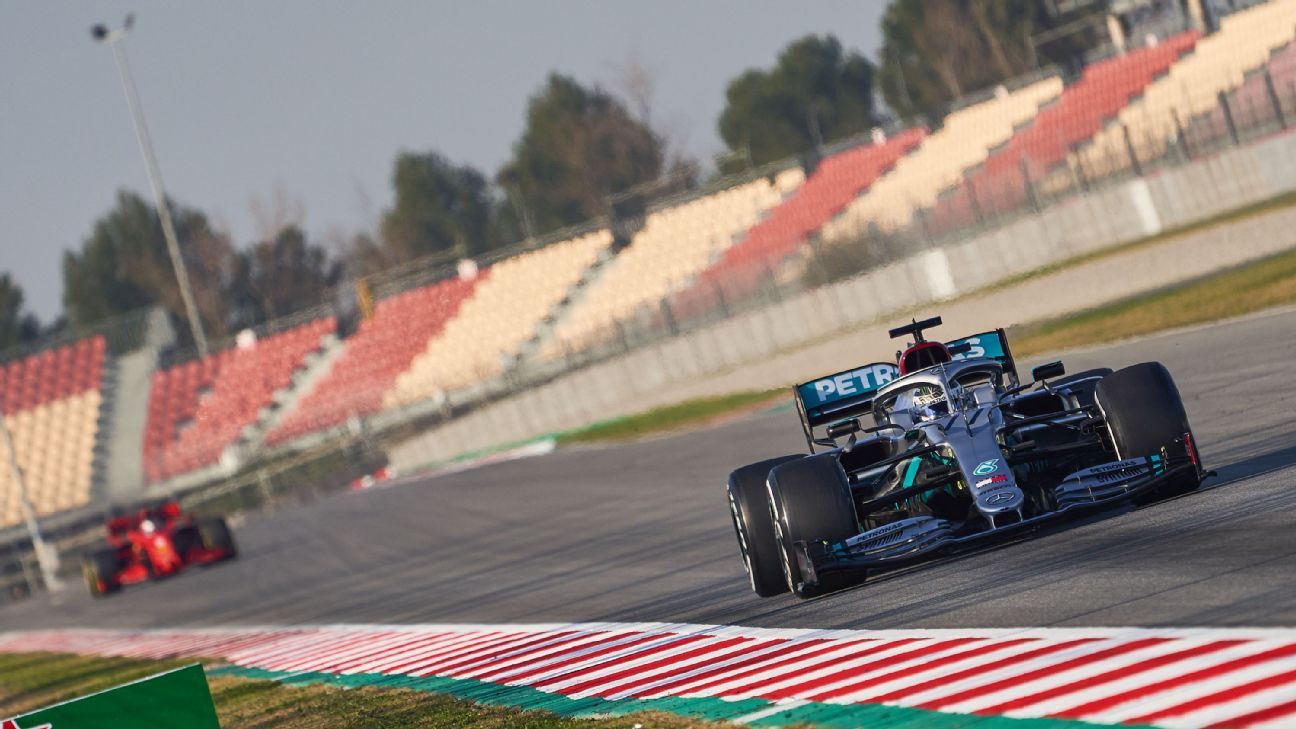Formula One’s plan to return to racing in July is dependent on a series of behind-closed-doors races in Europe.
F1 hopes to start the season with a spectator-free Austrian Grand Prix on July 5, which would see only essential personnel attend the race to execute and broadcast it effectively. If that goes smoothly, similar events in Britain and Hungary could follow.
While it’s hard to get a concrete figure, ball-park figures for a behind-closed-doors race range from 1,200 to 1,500 people, highlighting the scale of the F1 operation.
But how does that number translate across the teams and circuit staff? What happens if one of those people experiences another positive Covid-19 test, like the one which ultimately derailed the Australian Grand Prix?
Here we break down everything you need to know about the next type of F1 race you might be watching.
Creating a “biosphere”
In order to resume racing, Formula One will have to come up with a plan in which members of the paddock are tested for the virus, allowed to travel only if they show negative results and then kept safe for the duration of their trip. With international travel still massively disrupted due to government restrictions, it could only happen once lockdowns have been relaxed, which is why F1 is targeting a July start.
The sport’s motorsport director, Ross Brawn, has talked about creating “biosphere” in which paddock personnel can be safe. The plan is for those attending the race to be tested for Covid-19 prior to leaving their home country and then tested every two days to ensure they are still healthy.
Once cleared for travel they would travel on chartered flights, stay in hotels dedicated to F1 personnel and then jet back home with minimum contact with the local population. The Red Bull Ring in Austria lends itself to the plan as it is based at a remote location in the Styrian mountain range, has a nearby military airfield to fly into and spacious dining facilities at the circuit. A large dining hall underneath the media centre could cater for at least half the paddock, while the other half could make use of the Paddock Club facilities that are usually reserved for VIPs.
Brawn has made clear that teams would be kept apart from each other and those working between them, such as tyre fitters or members of the FIA would have procedures in place to ensure they and the team members they work with remain safe.
“We’ll have restrictions on how people move around within the paddock,” Brawn told Sky Sports. “We can’t have staff that socially distance so we have to create an environment within itself that is effectively a small bubble of isolation.
“The teams will stay within their own groups. They won’t mingle with other teams and they’ll stay in their own hotels. There will be no motorhomes there.”
Two races would be run over consecutive race weekends at the locked-down venues, allowing for more bang from the many bucks needed to set up the events. Assuming everyone sticks to the rules, those at the events should be at a very limited risk of infection, although staff working at the team hotels and any local residents working at the circuit could unintentionally contaminate the “biosphere”.
How many team members does it take to run two cars?
On a normal race weekend, the entirety of a team can be split into two distinct groups.
Operational staff
This is the core of a race team and includes anyone who’s job directly impacts the performance of a car.
This includes:
-
Senior management: Team bosses, chief engineers, strategists — basically those you would see on a pit wall during a live session.
-
Mechanics/pit crew: Those who do the hands-on work on the car during a race weekend.
-
Engine: A team’s engine supplier will provide mechanics to work in the garage for a race weekend, specifically on engine matters.
-
Pirelli: F1’s tyre supplier has a dedicated staff for each of the 10 teams.
-
Other technicians: Working on components such as brakes and radio.
Several teams have told ESPN the split is generally 40/45 senior management and mechanics, with 10/15 people to make up the engine, tyre and component technicians. F1’s rules cap the operational race staff at 60 people.
Non-operational staff
This is the core of staff working behind the scenes in the paddock. This is generally split between communications, marketing and hospitality teams.
This number fluctuates depending on the team and the venue. Smaller teams will usually have limited numbers wherever they are, although some of the bigger teams can nearly double the size of their whole operation at some of the more popular events on the calendar. One team told ESPN it takes upwards of 120 total staff to more popular events such as Singapore, the U.S. or Abu Dhabi due to the extra amount of non-operational personnel they bring to meet the demand of an increased number VIPs and guests.
Regardless of the team, this is the easiest part of a race team to cut down — these are the people F1 is looking to limit at a behind-closed-doors race. With no sponsors to look after, no VIP guests and no media beyond skeleton production crews, the number could easily be reduced and the lack of any motorhomes means a central catering team laid on by F1 and the circuit could feed each team’s staff.
Can teams operate with a skeleton race crew?
It’s easy to look at an F1 pit stop and suggest the number of mechanics could be cut in half. Each wheel takes three mechanics to change, so why not just have one per wheel like in IndyCar? Sure the pit stops would be slower but it would be the same for everyone, so no loss, right?
The only problem is that the pit stop represents just a fraction of the work each of those members completes every race weekend — they are not simply “pit crew”. Every one of them has an important role working on the car throughout the weekend and, given the complexity of the cars, cutting the number would make it pretty difficult to get two cars up and running over a race weekend, not to mention repaired if one has an accident.
F1 teams will continue to take the permitted 60 operational race staff to every event. With a minimal non-operational staff of around 20 expected to travel with them, you can effectively times 80 team members by the 10 teams and you have a ball-park figure of 800 people travelling from the respective team headquarters to each race
Who else would need to be there?
In order to run a safe and fair race, medical staff, marshals, scrutineers and the FIA’s safety and technical teams would all need to be present.
The biggest number out of those is marshals, with over 350 attending previous F1 races at the Red Bull Ring. It may be possible to reduce that number, but not significantly given the importance they play in ensuring the safety of the circuit during any given session of the weekend.
A full medical team would also need to be present in case of an accident and to carry out the rigorous testing plan.
F1 is still in discussions with its various broadcast partners about production crews but it seems any broadcast crew, including F1’s own centralised production team, will have to operate with as few people as possible.
Some TV broadcasters and commentators already work remotely, and it seems likely all TV stations would have to do the same if racing gets underway. Written media is also likely to be kept at bay while races remain behind closed doors, but some teams have already held press conferences and interviews online, so a similar model could work to provide driver quotes after track sessions.
What if someone tests positive?
In all likelihood, the Australian Grand Prix would have gone ahead as planned had a McLaren team member not tested positive for Covid-19 the Thursday before the race. The resulting fallout continued to haunt the sport for several weeks as its organisers looked underprepared and, at times, unaware of the severity of the situation as initially the sport considered carrying on regardless.
Even with strict testing regimes in place, there is still the possibility of a repeat when racing gets back underway. The sport would suffer hugely if a positive test derailed its plans to continue racing in Austria, but FIA medical commission chief Gérard Saillant said that would not necessarily be the case.
“The situation has evolved from Australia,” Saillant told L’Equipe. “We have provided a rapid response device to confirm the diagnosis, isolate and test people who have been in contact with a positive case.
“For me, the grand prix would not be cancelled. It is as if you were telling me that the metro is closed because a traveller has been positively diagnosed there.”
He reiterated the points made by Brawn regarding social distancing and revealed the FIA would also look to put in place tracking apps similar to those being considered by governments around the world.
“With a grand prix behind closed doors, there is no need for hospitality,” Saillant added. “Those present will be in a ventilated, unconfined space, and will have been selected.
“If they leave the circuit, according to very strict rules [same bus, same place, the same hotel], we will repeat the tests at a rate that remains to be defined by the local authorities and the WHO.
“Within this ‘bubble’, we are working with the legal department to set up, on a voluntary basis, an app which would make it possible to know what contact was made, less than a metre away, with someone positive.”
What would the race schedule look like?
Beyond the basic plan outlined by F1 to start in Europe at the Austrian Grand Prix and then move to Eurasia and Asia, North America and the Middle East, nothing has been defined. Ongoing discussions with promoters, teams and governments will ultimately decide what’s possible, but F1 is targeting two races behind closed doors in Austria, two races behind closed doors at Silverstone in the U.K. and then another race behind closed doors in Budapest.
Although nothing has been ruled out, it is clear street races in cities, such as Singapore and Vietnam, would require even more precautions.
“Each country has different regulations, and the situation of the circuit, of the hotels, will also influence this confinement rule,” Sallient said. “If the track is in the countryside, things are different than if it is in a city.
“Singapore or Vietnam would have a completely different medical organisation if they had a grand prix to organise now. Already, the Singaporean government could force the entire paddock to be isolated for a fortnight before we can access the track.
“For Austria, it’s different. The country is emerging from the crisis which, at home, has been relatively moderate. In this safe country, the rule of the game would be to do something in the even safer paddock.”
Proving how much of a clean slate the race schedule is now, F1 CEO Chase Carey admitted the championship is in discussions with venues which were not originally on the 2020 calendar to see if they might host a race. Carey was speaking after F1 revealed an 84 percent drop in revenues for the first quarter of the year.


